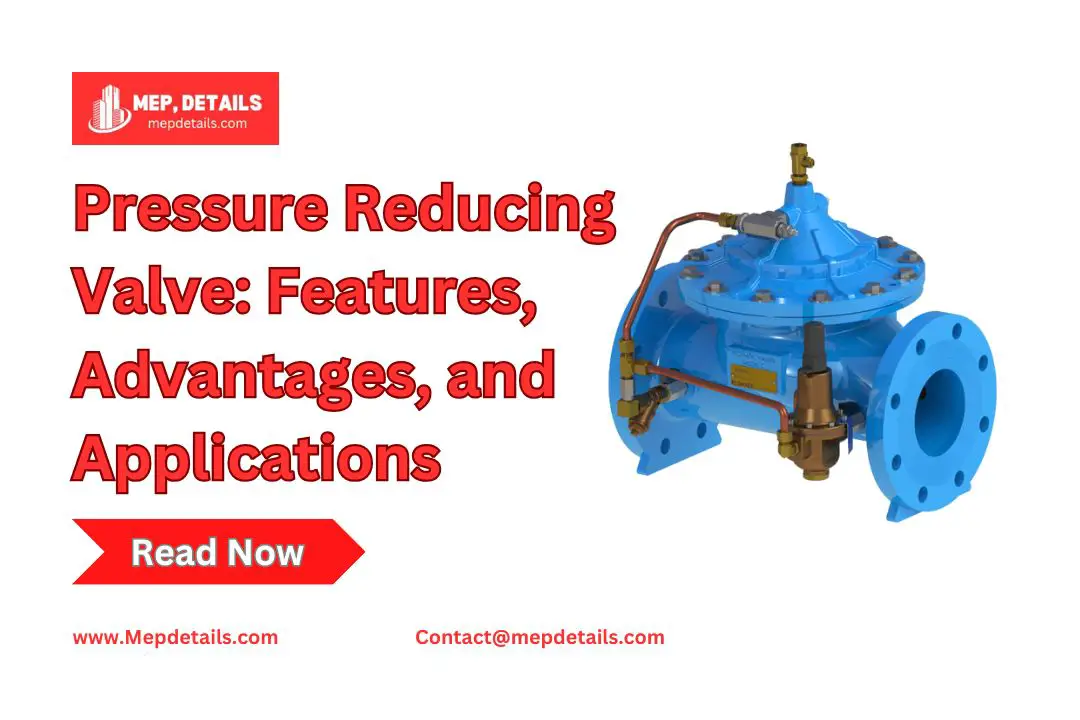A Pressure Reducing Valve works on its own to control upstream or downstream pressure. Its main job is to lower high pressure to a lower level. Industries like water, steam, and oil and gas use these valves frequently. In a steam system, the valve adjusts steam pressure using a spring. This simple idea forms the basis for most modern pressure-reducing valves. These valves come in two types based on how they control the valve opening: Pilot-operated pressure reducing valves and Direct-acting pressure reducing valves.
Features of Pressure Reducing Valve System
A pressure reducing valve manages pressure using a fully automated process that does not require an external power source. Its main functions include:
- Controlling pressure in steam systems accurately by adjusting the valve opening to keep the downstream pressure constant, even during changes.
- Preventing water hammers in certain situations when the valve is properly chosen.
- Acting as bypass valves to keep the system operational during power outages.
- Quickly sensing downstream pressure changes and adjusting to maintain stability.
Applications of Pressure Reducing Valves
Pressure reducing control valves are essential in various services. Here’s how they work in different applications:
Air or Gas Services
Compressed air systems, power tools, pneumatic control systems, and industrial gas storage and distribution systems rely on pressure reducing control valves. These valves can be direct-acting or pilot-operated, depending on the level of control needed.
Water Services
Domestic and industrial water distribution systems, as well as fire protection systems, use pressure reducing control valves. Direct-acting valves are commonly chosen for these applications.
Steam Services
Steam applications like direct steam supply, engines, and turbines frequently use pressure reducing control valves to manage steam pressure.
Other Services
Pressure reducing control valves also play a role in several additional areas, including:
- Heavy industrial equipment and rolling mill lubrication systems.
- Managing ram pressure in hydraulic presses.
- Controlling pressure in fuel-oil systems.
- Reducing pressure in sterilizers, unit heaters, humidifiers, and small process equipment.
- Extensive use in fertilizers, chemical processes, pharmaceuticals, and natural gas distribution industries.
Advantages of Pressure Reducing Valves
Pressure reducing valves offer many benefits. Here are the main ones:
- They don’t need external or extra energy to work.
- They use the line’s pressure energy to operate.
- Their pressure-balanced design keeps regulated pressure steady, even if inlet pressure changes.
- They are easy to maintain.
- Without stem packing, they avoid external leaks and reduce friction issues.
- They respond quickly.
Pressure Relief Valve vs. Pressure Reducing Valve
Here are the key differences between a pressure-reducing valve and a pressure-relief valve:
- A pressure-reducing valve keeps the pressure on the downstream side steady and lowers higher pressure when needed. A pressure-relief valve prevents damage by releasing pressure when it goes above a set limit.
- A pressure-reducing valve works continuously in the system, while a pressure-relief valve only activates when the pressure crosses the set limit.
- The pilot line in a pressure-reducing valve measures the outlet pressure, but in a pressure-relief valve, it measures the inlet pressure.
- During normal operation, a pressure-reducing valve stays open, while a pressure-relief valve remains closed.
Conclusion
A pressure reducing valve is essential for keeping pressure levels safe and efficient in many industries, working without the requirement for external power and adjusts to changes in pressure quickly while performing steadily. It is therefore a key requirement for systems like steam, water, and air, as well as specialized setups. Valves like pilot-operated and direct-acting valves offer great variety according to the purpose, ensuring the efficiency and safety of the system.
Understanding how these valves work, their benefits, and where they are used improve processes and safety in industry. The importance of these valves is evident in modern engineering.
FAQs
What is the function of PRV?
A Pressure Relief Valve (PRV) prevents excessive pressure from building up in pipelines or vessels. It limits the amount of compressed air pressure to avoid damaging machinery or harming people.
What is a valve used to reduce pressure?
Water pressure reducing valves come in two types: direct acting and pilot operated. Both use globe or angle style bodies, with newer versions available in an axial flow configuration.
What are the three types of PRV?
The three types of PRVs are acting-type, piston-type, and diaphragm-type.
What is the difference between PRV and PSV?
PRVs are adjustable and can be set to relieve pressure within a range, making them suitable for processes with fluctuating pressure. PSVs, on the other hand, open at a fixed pressure level, ensuring consistent safety.
Read More – Rainwater Harvesting System: Types, Steps, Advantages
